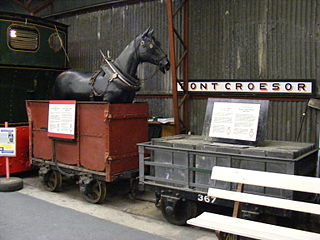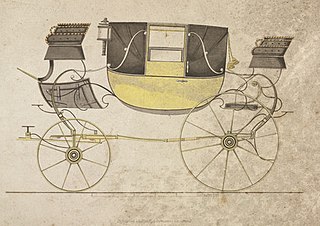 W
WA barouche is a large, open, four-wheeled carriage, both heavy and luxurious, drawn by two horses. It was fashionable throughout the 19th century. Its body provides seats for four passengers, two back-seat passengers vis-à-vis two behind the coachman's high box-seat. A leather roof can be raised to give back-seat passengers some protection from the weather.
 W
WA horse-bus or horse-drawn omnibus was a large, enclosed, and sprung horse-drawn vehicle used for passenger transport before the introduction of motor vehicles. It was mainly used in the late 19th century in both the United States and Europe, and was one of the most common means of transportation in cities. In a typical arrangement, two wooden benches along the sides of the passenger cabin held several sitting passengers facing each other. The driver sat on a separate, front-facing bench, typically in an elevated position outside the passengers' enclosed cabin. In the main age of horse buses, many of them were double-decker buses. On the upper deck, which was uncovered, the longitudinal benches were arranged back to back.
 W
WA Cidomo is a small horse-drawn carriage used in the Lesser Sunda Islands of Lombok and the Gili Islands of Indonesia.
 W
WA coach is a large closed four-wheeled passenger-carrying vehicle or carriage usually drawn by two or more horses usually controlled by a coachman, a postilion, or occasionally both. A coach has doors in its sides and a front and a back seat inside. The driver has a seat in front raised up high to give good vision. It is often called a box, box seat or coach box. The word coach came into use in the 15th century and spread across Europe. There are a number of types of coach depending on how the vehicle is to be used. Special breeds of horses, such as the now-extinct Yorkshire Coach Horse, were developed to pull the heavy coaches.
 W
WThe Concord coach is a type of horse-drawn coach, often used as stagecoaches, mailcoaches, and hotel coaches. The term was first used for the coaches built by coach-builder J. Stephen Abbot and wheelwright Lewis Downing of the Abbot-Downing Company in Concord, New Hampshire, but later to be sometimes used generically. Like their predecessors, the Concords employed a style of suspension and construction particularly suited to North America's early 19th century roads. Leather thoroughbraces suspend passengers who are in constant motion while the coach is moving. The swaying is accepted by passengers for the shock absorbing action of the leather straps and for the way the special motion eases the coach over very rough patches of roadway. This suspension, which was developed by Philip de Chiese in the 17th century, was long replaced by steel springs in England.
 W
WThe dandy waggon is a type of railway carriage used to carry horses on gravity trains. They are particularly associated with the narrow gauge Festiniog Railway (FR) in Wales where they were used between 1836 and 1863.
 W
WDurant-Dort Carriage Company was a manufacturer of horse-drawn vehicles in Flint, Michigan. Founded in 1886, by 1900 it was the largest carriage manufacturer in the country.
 W
WA horse and buggy or horse and carriage refers to a light, simple, two-person carriage of the late 18th, 19th and early 20th centuries, drawn usually by one or sometimes by two horses. Also called a roadster or a trap, it was made with two wheels in England and the United States. It had a folding or falling top.
 W
WHorse transports in the Middle Ages were boats used for effective means of transporting horses over long distances, whether for war or general transport. They can be found from the Early Middle Ages, in Celtic, Germanic and Mediterranean traditions.
 W
WA horse-drawn boat or tow-boat is a historic boat operating on a canal, pulled by a horse walking beside the canal on a towpath.
 W
WThe Horseboating Society is a national society, with the primary aim being the preservation and promotion of Horseboating on the canals of Great Britain. The Society was founded on 19 January 2001 at the Ellesmere Port Boat Museum, and it is the only organisation in the UK solely dedicated to horseboating.
 W
WA horsecar, horse-drawn tram, horse-drawn streetcar (U.S.), or horse-drawn railway (historical), is an animal-powered tram or streetcar.
 W
WIn coachbuilding, a landau is a four-wheeled carriage with a roof that can be let down. It was a luxury carriage. The low shell of the landau provides maximal visibility of the occupants and their clothing, a feature that makes a landau still a popular choice for Lord Mayors in the United Kingdom on ceremonial occasions.
 W
WA post-chaise is a fast carriage for traveling post built in the 18th and early 19th centuries. It usually had a closed body on four wheels, sat two to four persons, and was drawn by two or four horses.
 W
WA stage station or relay station, also known as a staging post, a posting station, or a stage stop, is a place where an exhausted horse or horses could be replaced by fresh animals. A long journey was much faster with no delay to rest horses.
 W
WStage wagons are light horse-drawn or mule-drawn public passenger vehicles often referred to as stagecoaches. Like stagecoaches they made long scheduled trips using stage stations or posts where the horses would be replaced by fresh horses. Stage wagons were intended for use in particularly difficult conditions where standard stagecoaches would be too big and too heavy.
 W
WA stagecoach is a four-wheeled public transport coach used to carry paying passengers and light packages on journeys long enough to need a change of horses. It is strongly sprung and generally drawn by four horses.
 W
WIn railroad terminology, a stock car, cattle car, cattle truck or cattle wagon is a type of rolling stock used for carrying livestock to market. A traditional stock car resembles a boxcar with louvered instead of solid car sides for the purpose of providing ventilation; stock cars can be single-level for large animals such as cattle or horses, or they can have two or three levels for smaller animals such as sheep, pigs, and poultry. Specialized types of stock cars have been built to haul live fish and shellfish and circus animals such as camels and elephants. Until the 1880s, when the Mather Stock Car Company and others introduced "more humane" stock cars, death rates could be quite high as the animals were hauled over long distances. Improved technology and faster shipping times have greatly reduced deaths.
 W
WA team boat, horse boat, or horse ferry, is a watercraft powered by horses or mules, generally using a treadmill, which serves as a horse engine. Team boats were popular as ferries in the United States from the mid-1810s to the 1850s.
 W
WA horse trailer or horse van is used to transport horses. There are many different designs, ranging in size from small units capable of holding two or three horses, able to be pulled by a pickup truck or even a SUV; to gooseneck designs that carry six to eight horses, usually pulled by 1-ton dually-style pickups. There are also large semi-trailers that can haul a significant number of animals. In the UK, a horsebox may also refer to a motorised vehicle adapted to carry horses, or a railway vehicle specifically designed to carry horses.
 W
WA wagonette is a small horse-drawn vehicle with springs, which has two benches along the right and left side of the platform, people facing each other. The driver sits on a separate, front-facing bench. A wagonette may be open or have a tilt. A large horse-drawn enclosed vehicle with spring-suspension, a similar arrangement of the seats and obligatory roof is called a horsebus.